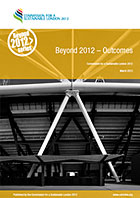
Waste is an area where London 2012 has the potential to set new standards of sustainability – both in the construction sector and for large events. It is an area where anyone attending the Games will have a part to play. The London 2012 sustainability policy commits to catalysing waste infrastructure in East London through the power of the Games.
Demolition and construction waste
So far, the ODA have achieved industry-leading performance for demolition and construction waste. For demolition, the ODA have achieved in excess of the target of 90 percent reuse or recycling, set in their Sustainable Development Strategy. The sitewide construction waste contractor is achieving in excess of the target of 90 percent diversion from landfill for construction waste. Both of these performances set standards for the rest of the construction industry to follow.
These achievements have been largely through recycling or down-cycling of materials. We have recommended that a specific target for reuse is set for transformation.
Recycled content
In its Sustainable Development Strategy, the ODA committed to achieving at least 20 percent recycled content by value in their venues and at least 25 percent recycled content by volume of aggregate used. Current performance is well in excess of these targets, with good use of WRAP quick wins and recycled aggregate coming from demolition materials.
Games-time waste
A commitment was made in the bid that London 2012 would be a zero waste Games. This followed through into the London 2012 Sustainability Plan where London 2012 set the challenging target of zero waste direct to landfill at Games-time. This is supported by a target for at least 70 percent of this waste being reused, recycled or composted. Plans have been developed to achieve this and an overall waste contractor has been appointed. There are various challenges that will need to be addressed to meet these targets but a key study has shown that it is achievable. One key issue will be the material that food containers are made of. It is currently intended that they will be compostable so that waste food and food packaging can be composted together.
If LOCOG implement all their plans for waste management they will deliver an exemplary waste solution for the Olympic and Paralympic Games.
Transformation
The London 2012 Sustainability Plan contains the commitment to ‘take reasonable endeavours to reuse or recycle at least 90 per cent, by weight, of the material arising from the installation and deconstruction of its temporary venues and overlay (stretch target). The OPLC has indicated that it will continue the ODA targets for waste management. We welcome the commitment to reuse or recycle at least 90 per cent of materials, but we are of the view that a specific target for reuse of materials needs to be set. The Commission also recommends that there is greater coordination of waste and materials arising in transformation after the Games.
The Commission
In 2010, the Commission published “No time to waste”, a review of waste across the London 2012 programme. This sets out comments and makes recommendations. The current performance against these recommendations can be found in our recommendations tracker.
The Commission will continue to monitor waste and resource management as part of its remit and has been reviewing how the plans within LOCOG are being turned into actions. A report of the preparations for staging sustainable Games will be published early in 2012.
